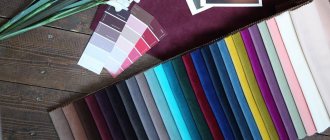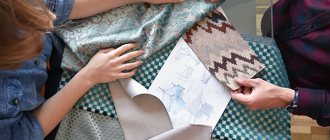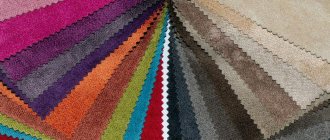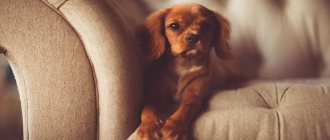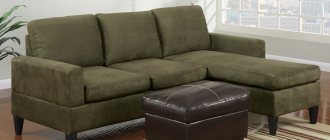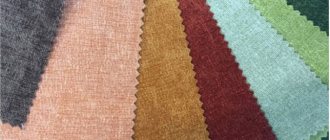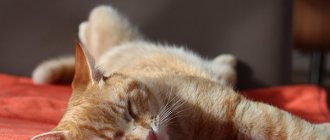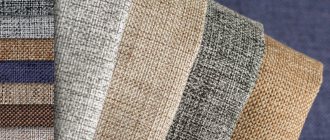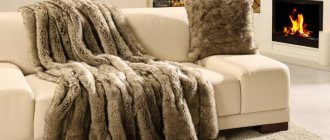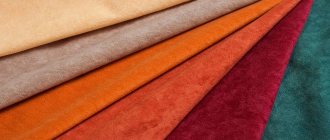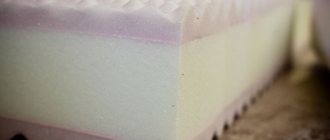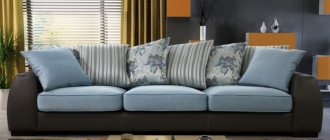Velor sofas
Velor is often used as a material for furniture upholstery. Outwardly, it is very reminiscent of velvet, so velor sofas look very original and presentable. The modern range of these pieces of furniture is presented in a wide range, among which you can see models for every taste. They are very beautiful, practical and functional.
External effects of velor fabric
In order to choose which velor is best for upholstering a sofa, you need to take into account the purpose of the room in which the furniture is installed and the style of its design. The material may have a surface:
- smooth - with uniform vertical pile;
- shaped - with a pronounced texture, which is formed by vertically and obliquely located pile, having different heights and shades;
- embossed - with a pattern that is formed when the pile is laid in different directions;
- plain-dyed - with uniform coloring.
Advantages and disadvantages
A stylish velor sofa has always been particularly popular. Velor is very pleasant to the touch, and also carries with it a certain nobility, which makes it in demand in various fields. Such upholstery can create an amazing play of colors, giving a particular product uniqueness and charm.
A material such as velor has many advantages over other options. Velor sofas have the following advantages:
- strength;
- wear resistance;
- presentable;
- delicate texture;
- functionality;
- hypoallergenic;
- unpretentiousness in care;
- at an affordable price.
Velor furniture has virtually no disadvantages, since the most modern technologies are used in its production process and the wishes of consumers are taken into account.
What kind of material is this?
Translated into Russian, “velor” means “shaggy, fluffy, fleecy.” And indeed it is.
Velor fabric, used for furniture upholstery, is a dense, durable material with an even, thick pile. It is also used for covering soft wall panels.
It looks unusually beautiful, is pleasant to the touch, and can decorate the interior with subtle tints of shades. It is made from natural, artificial, synthetic fibers and mixtures thereof.
Most often these are cotton, viscose, polyamide and polyester.
This composition allows not only to give the fabric wear resistance and durability, but also to create fabric with different external effects.
- Smooth velor - with a uniform structure and vertically located pile.
- Shaped - heterogeneous, with a pronounced texture, in which the pile can be inclined, of different heights, of different shades.
- Printed - with a colored pattern.
- Embossed - velor with a pattern formed by laying the pile in different directions, which gives the fabric a similarity to other, even more expensive textures - for example, crocodile skin.
- Plain painted - the most expensive and beautiful in appearance, with a uniform color.
It is difficult for a non-specialist to distinguish by sight, for example, velor for furniture, velvet, corduroy, micro-velvet and other types of pile fabrics. All of them have a velvety pile surface that shimmers in the light like fur.
The main thing you need to know when choosing a type of furniture is that it is very dense, heavy, and the pile on it is located with a high density.
Which fabric is better?
Basically, for upholstery of sofas, manufacturers use strong and durable materials, each of which has individual characteristics. Therefore, before making a choice in favor of one or another sofa upholstery, it is recommended to decide for what purpose it is being purchased, and only after that give preference to a specific type of fabric.
It must be remembered that a beautiful velor sofa can give the interior a special coziness. Each upholstery material has its own individual characteristics and differences that should be paid due attention. The most popular among the entire range are the following items:
- Flock. A relatively inexpensive material that is actively used for furniture upholstery. It is made of 65% polyester and 35% cotton. This is an ideal option for animal owners, since this fabric is easy to care for, easy to clean, does not fade, and is also hypoallergenic, waterproof, and wear-resistant. The material allows air to pass through well, preventing the accumulation of unpleasant odors and is very pleasant to the touch.
- Chenille. It has a chic appearance and is considered an exclusive upholstery material. It is hypoallergenic, resistant to adverse environmental factors and easy to clean. This fabric perfectly retains its original qualities and color for many years, as it does not deform at all and does not fade.
- Velours. Very delicate material with a soft velvety surface, which provides the most comfortable and cozy rest. This fabric is resistant to stretching, so it is often preferred to be used in complex furniture structures.
It is a little demanding to care for, but it can still be cleaned with a vacuum cleaner with a soft brush, as well as treated with special water-based products.
- Jacquard. It is an exquisite and noble material with incomparable strength and durability. In terms of cost, this upholstery fabric is much more expensive than others. It is often compared to a tapestry due to the presence of a pronounced relief pattern. The fabric can only be cleaned using the dry method.
- Matting. It has a very dense and durable texture with a fleecy surface. The design looks very much like a chess pattern. This fabric is made from cotton, polyester and acrylic, which indicates the impeccable quality of the material. In any interior, this upholstery looks as natural as possible.
- Tapestry. This is a well-known cotton fabric with a thick weave of threads. It is not so refined, but has decent quality indicators, such as wear resistance, practicality and good breathability. This material perfectly retains its original characteristics for many years.
- Microfiber It is considered a novelty among upholstery materials. Very strong, durable, perfectly retains its original color, fireproof and resistant to adverse factors. A good option for those with pets due to its resistance to claw snags.
Each of these upholstery materials is unique in its own way. Therefore, in the selection process it is necessary to take into account all the features of a particular specimen. After all, only a properly chosen soft sofa will delight its owners and others not only with its attractive appearance, but also with its comfort.
Main types of fabric depending on composition
Based on its composition, matter is divided into natural, artificial and mixed materials.
Polyester. Synthetic fabric widely used in furniture upholstery. It is highly durable, which is why it is preferred by many textile industries.
Polyester
Acrylic fabric has a bright, stylish design that does not deteriorate from the aggressive influences of nature and frequent washing. The fabric can serve for a long time due to its durability and practicality. The acrylic version is inexpensive and is mainly used in the furniture industry.
Acrylic
Mixed fibers. The fabric may consist of a mixture of different threads, which can be either natural or artificial substances.
The chenille material made from viscose threads looks unusual: it shimmers and has a beautiful sheen.
Viscose
Attention: Natural ingredients make the fabric clean and safe to use. In addition, cotton increases the life expectancy of products. An important fact is the absence of accumulation of static electricity by the fabric.
Cotton
Which to choose?
The choice of a velor sofa should be approached with great responsibility. The color of the product plays a very important role when choosing. Designers recommend choosing the shade of the sofa that will harmoniously combine with other interior items and become its important component. In this case, it is necessary to take into account your lifestyle, as well as your character. After all, some people like bright colors, while others are delighted with calmer shades.
Each interior style includes a combination of certain color schemes, which should definitely be taken into account when choosing a velor sofa. They all have individual characteristics:
- Red . For some it can cause aggression, but for others it can become a symbol of romance and comfort. The most original way such a sofa complements interior design in the style of Art Deco, High-Tech, Constructivism and Techno.
- Blue. Psychologists say that this color has a positive effect on the human psyche, conducive to relaxation and tranquility. They can often be found in a classic style.
- Green. A velor sofa in this color can become the center of everyone's attention. It goes well with yellow, blue, pink and red items. This shade can cause drowsiness. It complements the Baroque style well.
- Brown. The presence of such a sofa ensures the creation of comfort and coziness. It is used in Country, Empire, Renaissance, Classic and Rococo styles. It goes perfectly with beige, yellow, blue, lilac, orange.
- Black. A beautiful velor sofa in this color looks original in bright and spacious rooms. It goes well with gray, red, yellow, turquoise and burgundy. It is often used in the Minimalist style.
- Grey. A sofa in this color fills the room with clarity and conciseness. It goes well with yellow, red and purple. Used in gothic and minimalist style.
- White. This sofa brings light and newness to the room. Therefore, it can often be found in the Art Nouveau style. Combines harmoniously with golden, beige and gray colors.
When is flock better, and when is chenille?
Before choosing suitable upholstery for future furniture, you need to assess how intensively it will be used and for what purposes it will serve.
Important! It should be remembered that the sofa should be in harmony with other interior items and at the same time be the central item in the room. It is to match its color that curtains are chosen, walls and floors are finished.
Flock and chenille are excellent upholstery options, but their features must be taken into account when choosing upholstered furniture.
Source: tkaner.com
Chenille fabric for a sofa: pros and cons
Increasingly, for sofa upholstery, buyers choose a pleasant fabric similar to velor or corduroy, chenille, which appeared more than 200 years ago in the USA. The origins of the original fluffy threads come from Europe, and the name itself has French roots (chenille French - caterpillar). The really fluffy fibers wrapped around the base resemble a caterpillar. Today, the choice of practical upholstery fabric, called chenille, is quite wide and in demand. Its popularity is easily explained by its practicality, aesthetic properties and reasonable price.
Photo gallery
To choose a better fabric for upholstery, look at the photo from the gallery: how specific products look in the interior.
Description of chenille
As in the case of jacquard, chenille is not the material itself, but the yarn from which it is woven. Materials with chenille thread are strong, durable, pleasant to the touch and look beautiful. The main advantage of sofa upholstery is the huge number of color and texture options. The characteristics of the fabric provide mainly positive customer reviews.
What is better - chenille, flock, velor, matting, jacquard or tapestry?
Chenille upholstery for sofas is highly wear-resistant, environmentally friendly, and durable. On the modern market it is presented in a wide variety of shades, unlike many other upholstery models, which is its undoubted advantage.
- Flock is not afraid of snagging and is considered washable (unlike chenille upholstery for sofas). The material is durable, pleasant to the touch, soft, and relatively inexpensive. However, it cannot boast of a variety of shades.
- Jacquard retains color well, is not subject to temperature changes, is durable, strong, does not wear out, and can be washed. The main disadvantage is the relative high cost due to the complexity of production.
- Tapestry is similar to jacquard. The only difference is that jacquard uses fewer threads of different colors. Also, tapestry is usually made from more expensive and thicker 100% cotton thread.
- Matting is well suited for upholstering sofas; it looks aesthetically pleasing and cozy, but for many it is too rough to the touch.
- Velor does not stretch, is available in a variety of shades, and is highly breathable, but removing dirt from it is a big problem.
Comparison of chenille with other upholstery fabrics
The range of upholstery fabrics is huge, unfortunately, it is not limited to one type. Only furniture chenille has several varieties. It’s easy to get confused in the store; the annoying question “which is better” immediately arises:
- Chenille or matting? Chenille or velor? Chenille or flock? Tapestry or chenille?
This table will help you understand the difference between these fabrics.
| Fabric name | chenille | matting | velours |
| Fabric properties | |||
| Description | Soft, dense, fleecy fabric consisting of chenille threads | Rough but soft fabric with a fleecy surface and a silky sheen | Elegant, dense fabric with thick, velvety pile |
| Blade type | Woven, fabric-adhesive | Woven | Woven |
| Compound | Cotton, artificial fibers | Natural: cotton, linen, wool, silk; mixed: natural threads with synthetic fibers (polyester, acrylic) | Natural: cotton, linen, silk; mixed: natural threads with synthetic fibers |
| Colors | Plainly dyed, plain ornament or pattern, printed, woven pattern/subject | Plain dyed, melange, printed | Plain dyed, printed, woven pattern/subject |
| Peculiarities | Soft, elastic, wear-resistant, environmentally friendly, hypoallergenic | Rough, soft, wear-resistant, environmentally friendly, hypoallergenic | Soft, wear-resistant, environmentally friendly, hypoallergenic |
| Cleaning | Dry cleaning, dry cleaning | Wet cleaning: in a washing machine (delicate mode, temperature 30 degrees) without using chlorine-containing products; dry cleaning | Hand and machine wash (delicate mode, temperature 30 degrees) without the use of active chlorine-containing products; dry cleaning |
| Ironing | No ironing | Does not require ironing, but if necessary, can be ironed with a low-heat iron from the reverse side | Does not need ironing |
| Drying | Moisture should be avoided | Away from direct sunlight, no spin | Away from direct sunlight, no spin |
| Where is it used? | Furniture upholstery, wall upholstery, curtains, bedspreads | Furniture upholstery, upholstery of interior pillows, sewing curtains, bags, clothes | Furniture upholstery, upholstery of interior pillows, sewing of bedspreads, curtains, bags, clothes |
| Price | 500-8,000 rubles | 250-4,000 rubles | 300-1,500 rubles |
| Fabric name | flock | tapestry |
| Fabric properties | ||
| Description | Thick fabric with velvety pile | Thick fabric with a woven pattern |
| Blade type | Non-woven | Woven |
| Compound | Natural (cotton, wool), artificial (polyamide, polyester, viscose, acrylic, acetate, polypropylene), mixed | Natural: cotton, linen, silk; mixed: natural threads with synthetic fibers |
| Colors | Plain painted, colored | Woven pattern |
| Peculiarities | Soft, wear-resistant, does not absorb moisture | Dense, soft, lightweight, wear-resistant, environmentally friendly, hypoallergenic |
| Cleaning | Hand and machine wash (delicate mode, temperature 30 degrees) without the use of active chlorine-containing products; dry cleaning | Hand and machine wash (delicate mode, temperature 30 degrees) without the use of active chlorine-containing products; dry cleaning |
| Ironing | Does not require ironing, but if necessary, can be ironed with a low-heat iron from the reverse side | Does not require ironing, but if necessary, can be ironed with a low-heat iron from the reverse side |
| Drying | Away from direct sunlight, no spin | Away from direct sunlight, in a horizontal position, without spinning |
| Where is it used? | Furniture upholstery, upholstery of interior pillows, sewing curtains, clothes, toys | Upholstery of furniture, covering of interior pillows, creation of paintings, sewing of bedspreads, curtains, bags, clothes |
| Price | 150-2,000 rubles | 200-5,000 rubles |
Advantages and disadvantages
Among the obvious advantages of the material, the following factors can be identified:
- It does not lose its original appearance even after several washes.
- In addition, after a lot of cleaning operations, the fabric does not shrink or fade.
- A variety of colors, shades, tones, patterns, ornaments and patterns. The abundance allows everyone to find the best canvas option for themselves.
- Absorption of noise and light. This is an advantage of the fabric, which is why it is preferred in the manufacture of curtains and drapes.
- When a huge part of the composition is represented by cotton, then we can safely say that such fabric is environmentally friendly and safe for people. Allergy sufferers should not be afraid to use such products.
- The material does not tend to absorb odors.
- Strength and resulting durability.
Type of chenille yarn
Flaws:
- Hygroscopicity. It easily absorbs moisture, so furniture and other products must be protected from moisture.
- After water gets in, stains form on the material.
What upholstery to choose for a sofa
- For sofas in the living room, upholstery is usually made of leather or fabric with a clear pattern (tapestry, jacquard). These materials reflect the style of the owners of the house better than others.
- For a sofa in the kitchen, faux leather upholstery would be good (easy to clean, does not absorb odors).
- For furniture in the nursery, we recommend not too expensive upholstery materials - with a calm pattern, resistant to stains (flock, chenille, artificial leather). It is important that children's furniture can be easily cleaned.
- For a home with pets , a material is suitable that is difficult to leave snags and holes on. And caring for it should be easy. Example: flock. If you really want a different upholstery (for example, leather), the sofa will need to be covered with a cover.
- Abrasion-resistant materials are suitable for offices The best choice is natural or artificial leather.
- Materials that easily absorb odors are not suitable for rooms where people smoke Chenille and leather behave well in smoky rooms.
We will talk about these materials in our review. In addition to those mentioned, the following materials are used in the upholstery of sofas:
- bouclé (fabric with bouclé thread, has an uneven surface)
- matting (thick fabric, a type of chenille)
- suede
- microfiber and some others.
To improve the properties, furniture fabrics are treated with protective impregnations (Teflon, Scotchgard, etc.). This processing:
- increases the service life of the upholstery,
- makes the surface resistant to moisture and dirt (including grease),
- makes it easier to care for.
The liquid will simply roll off the sofa. The problem of stubborn stains (oil, tea, coffee, juice, etc.) will also be solved.
The difficulty is that externally the buyer will not be able to distinguish fabric with Teflon from fabric without Teflon. To avoid buying a “pig in a poke,” ask the seller for documents and certificates. The usual advice - to buy furniture in large showrooms from well-known manufacturers - is also appropriate here.
Choosing fabric for interior design
Today, interior designers use many wonderful materials in their work. Particularly popular fabrics are:
- antistatic,
- repellent dust,
- Dirt-resistant.
Thickness, weave, technical parameters of the material are very important, but also pay attention to color and design. How to choose upholstery for the perfect sofa that will become a real star of the interior?
Color according to interior style
Color is quite important and can range from fresh, cool tones, warm, energetic shades, to a calm neutral color palette. In a marine style interior there is a wonderful choice:
- thin blue,
- invigorating turquoise,
- strong sapphire.
In oriental interiors, pop art styles look like:
- warm white oranges,
- sunny yellow,
- temperamental scarlet.
When choosing a classic decor, you should stick to balanced colors:
- noble gray,
- beige.
Harmony or an intriguing highlight of the program?
The sofa can harmonize with the interior design or create an unusual counterpoint - the highlight of the program.
- Harmony will be created by fabric that matches the tone of other materials - curtains, carpet.
- If homeowners prefer contrasts, you can choose fuchsia upholstery against a background of cream wallpaper - a solution favored by Scandinavians who decorate spaces with bold colors.
Plain design or bold patterns?
Plain monochrome upholstery is a reliable basis for interior design. Smooth plain surfaces are not obligatory; you can “go crazy” with the help of colorful pillows and decorative wallpaper.
Fans of bright solutions will be able to enjoy cheerful stripes and colored melanges. When choosing patterned upholstery, you need to remember moderation and not overdo it with accessories. It’s a good idea to add other fabrics with similar shades and patterns to the interior, for example, on napkins or curtains.
Room size matters!
It is important to consider the size of the room. If the design and upholstery colors are too intense, the space will seem overwhelming. Fabrics with a subtle color palette look great in a small room:
- blue, ash, elegant ecru will add light and lighten the room;
- One colored material with an embossed, embroidered texture will help relieve boredom.
When updating furniture, sometimes you have to change the upholstery of the sofa, which fabric is better - the choice should be made individually for each interior, the prevailing conditions in it, how and by whom the furniture is used, how often it is exposed to contamination. You shouldn’t skimp on fabric; high-quality material will last longer without causing any trouble.
Furniture flock
Flock is the most common material for upholstery of sofas. You will find furniture with flock in different price categories (both budget and luxury options).
Flock is produced by applying nylon pile to a base under the influence of an electrostatic field (this process is called flocking). Base composition: cotton and polyester. Flock imitates other upholstery materials - in appearance it can look like velor, suede, or chenille.
This effect is achieved through the use of different piles. Flock is difficult to tear, so he is almost not afraid of cat claws. Stains are easily removed with soap and water. Flock is often treated with protective impregnations.
When cleaning a flock sofa, you should not use alcohol or strong solvents (the surface will become bald).
A sofa with flock upholstery is well suited for almost any situation - for families with small children, for a home with animals, for living rooms, children's rooms, bedrooms, dining rooms. Suitable even for furniture that will stand on a loggia or veranda (it will not “stiffen” when cooled).
Flock is not suitable except for kitchen sofas and rooms where people smoke (it easily absorbs odors). If you have a choice, it is better not to take flock for transformable furniture (it is wiped off at the joints of parts).
Advantages of flock:
- lasting;
- waterproof;
- pleasant to the touch;
- easy to clean, does not get greasy;
- difficult to tear, does not cling;
- resistant to temperature changes;
- dust and wool stick little;
- large palette of colors and patterns
Advantages of fabric upholstery
- Variety of colors and patterns. So, you can choose a material for a sofa that will fit most harmoniously into the interior of the room, will correspond to the design idea, and will be an excellent continuation or bright accent of the room.
- Protection of the interior of furniture. Here we mean that a high-quality coating repels dust, dirt, and water, which is good both for the material itself and for the mechanisms of the sofa/chair.
- Easy care. Almost all modern materials are easy to care for; rare ones have some restrictions and rules. All this eliminates the need to call dry cleaning, the long process of removing stains, and so on.
- Price. Most upholstery options can be purchased inexpensively. And today cheaper alternatives have been invented for expensive solutions.
Furniture chenille
Chenille is a very practical upholstery. It feels like corduroy, but softer and more pleasant to the touch. Often used for children's furniture. Not suitable for pet owners.
Pros of chenille:
- lasting;
- wear-resistant;
- pleasant to the touch;
- does not cause allergies;
- does not absorb odors;
- the color is well preserved and fades little;
- not subject to deformation, does not stretch.
Cons of chenille:
- high price;
- absorbs moisture;
- Cat claw marks will be clearly visible.
Care instructions
Chenille is a rather demanding material. With proper care, it is able to maintain its original image for a long time.
- Avoid exposing the material to ultraviolet rays from the sun.
- It is necessary to protect products from exposure to high temperatures and moisture.
- It is best to dry clean the fabric. The material is too delicate and requires the attention of professionals.
- It is necessary to avoid contact of matter with sharp objects. Pets can easily damage the material with their claws, so if a pet lives in the house, it is better to avoid upholstery.
- It is necessary to wash away stains immediately. Using a sponge soaked in a solution consisting of equal proportions of water and detergent, you can carefully apply the mixture to the stain. When the water dries, the product must be thoroughly vacuumed.
Pattern with damask patterns on light, cream backgrounds
Furniture jacquard
Jacquard is a very dense (even stiff) upholstery fabric with a wide variety of patterns. It does not fade in the sun, is wear-resistant, lasts a long time, so it is ideal for a sofa in the living room. Absolutely not suitable for a house where there is a cat (claws will leave puffs).
Advantages of jacquard:
- strength;
- rigidity;
- wear resistance;
- resistance to sunlight (does not fade);
- long service life;
- pleasant to the touch;
- a wide range of patterns and colors;
Disadvantages of jacquard:
- sensitive to moisture;
- Difficult maintenance (only dry cleaning is acceptable);
- Everyone likes the slippery surface.
Story
The matting material traces its history back to the cattail plant, from which peasants wove various things needed on the farm. But then he was rude.
In a more modern form, the fabric found a second wind thanks to Coco Chanel, the famous fashion designer. This fabric came to be called “Chanel”.
Types of fabrics
For your information! Coco Chanel, fascinated by everything Russian, came up with the idea of using burlap and matting in clothes, giving a vector for the development of fabric manufacturing technology.
One type of Chanel fabric
Furniture velor
Velor furniture has a beautiful velvety sheen. Looks very impressive in the living room. Wet cleaning of such furniture is acceptable. You should also regularly clean the surface with a vacuum cleaner (furniture attachment with soft bristles). The disadvantage of velor is its tendency to abrasion.
This problem can be solved by covering the sofa with a special cover, from under which individual areas that are not subject to heavy load will be visible. Velor is suitable for upholstering a sofa in the living room or bedroom.
It's hard to imagine a home where there are children and there are never stains or spilled tea. Therefore, a velor sofa is not suitable for families with children.
Advantages of velor:
- spectacular appearance;
- soft;
- pleasant to the touch;
- allows air to pass through (“breathes”);
- does not stretch
Disadvantages of velor:
- short-lived;
- very capricious, demanding care;
- stains are very difficult to remove;
- the pile wears out over time.
How to care for a sofa with velor upholstery?
Caring for velor upholstery is not difficult if it is carried out regularly using a special brush or vacuum cleaner with a rubber nozzle strictly in the direction of the pile. For care, do not use fluffy rags, which can leave whitish spots on the fabric. It is not recommended to use powdered cleaning compounds, bleaches or products containing solvents.
Pollution cleaning technology:
- wet a microfiber cloth in a mild soap solution;
- Apply the solution to the contaminated area, rub the microfiber cloth in the direction of the pile without applying strong pressure;
- dry naturally.
The most resistant to all types of dirt and ultraviolet radiation is velor fabric coated with Teflon.
Furniture genuine leather
The price of sofas upholstered in genuine leather is high. And not without reason. A leather sofa will serve you for a long time. This is partly why leather is chosen for office spaces, executive offices, expensive hotels and conference rooms, and home libraries. The second reason for this choice is prestige. A leather sofa immediately denotes the high status of the owner.
Caring for a leather sofa is easy: just wipe the surface with a damp cloth. There are special care products for leather furniture that will help you maintain the appearance of your sofa.
Remember - a good leather sofa should not be cheap! A low price also indicates low quality leather or paint. If you are on a limited budget, it is better to buy leatherette.
- Tip: choose a leather sofa with individual pillows. If the surface does wear off and lose its appearance, you can start by simply replacing the pillows.
Advantages of genuine leather:
- luxurious, expensive appearance;
- natural;
- durable;
- durable;
- moisture resistant;
- easy to care for.
Disadvantages of natural leather:
- high price;
- afraid of fire (including cigarettes);
- the range of colors is much smaller than that of woven materials;
- may feel cold to the touch;
- “sticks” to unprotected human skin;
- may crack over time (especially if not properly cared for).
Caring for velor furniture
If you decide to buy velor furniture, be prepared for the fact that the material requires special regular care. The surface practically does not repel dust, so stains will appear on a sofa or armchair quite often. To at least slightly prevent their occurrence, have your upholstery professionally cleaned with a steam generator every six months or a year. Steam will not only clean the surface, but also destroy bacteria and microorganisms.
Carry out regular dry cleaning with a vacuum cleaner at least once every 7 days. Buy a special brush and roller for caring for velor, which will collect stuck lint and dust.
Furniture artificial leather
Leatherette is an ideal option for those who need a leather surface (or just really want it!), but don’t have enough money. Faux leather is excellent for kitchen furniture and children's sofas, as it does not absorb odors and is easy to clean.
Yes, the pattern of artificial leather is not as varied as, for example, tapestries. But if you don’t like simple colors and classic interiors, you can throw a few colored pillows on a plain sofa and the problem will go away.
Pros of artificial leather:
- cheaper than genuine leather;
- soft, pleasant to the touch;
- moisture resistant;
- very resistant to abrasion;
- easy to care for;
- No animals were harmed during its production.
Cons of artificial leather:
- the surface is prone to scratches and may crack over time;
- “sticks” to unprotected human skin;
- afraid of fire.
Differences and similarities between velor and micro-velor
Microvelor is a close relative of velor furniture covering; in appearance they are very similar. At the same time, velor and micro-velor have the following differences:
- The length of the pile in microvelor does not exceed 1 mm, in velor it is longer - up to 3 mm.
- The weaving of the base of microsuede is carried out in honeycombs, and its relative is reminiscent of the Latin letter W.
- Furniture velor is a denser fabric than micro-velor.
- Microvelor is treated with a special coating, which makes the material resistant to stains.
What else is the difference between velor and micro-velor? How to iron and wash velor? It is hand washable and can be ironed on the reverse side. Caring for velor is easy, since things made from this material practically do not wrinkle. A velor sofa in the interior will create a feeling of comfort throughout the room. But it is very sensitive to mechanical damage. Cat's claws will seriously ruin the appearance.
Velor sofa
Summary
Whatever upholstery you choose for your sofa, remember the following general care rules. They are simple, but if you follow them, even cheap upholstery will last you a long time. What can we say about the road! So:
- do not place the sofa close to the heat source (radiator), do not place heaters nearby;
- do not use cleaning products that are not intended for furniture (especially with bleaches);
- Take care of your sofa regularly and try not to spill anything on it (even if the upholstery is stated to be waterproof).
And – enjoy your holiday on your new sofa!
How to change old upholstery yourself
You can change the upholstery on furniture yourself if you have experience in reupholstering furniture.
Removing the upholstery
First, you should carefully measure all the parameters of the furniture and add about half a meter of fabric just in case of fire. You should either attach new upholstery to a well-cleaned old one, or remove the old one and re-upholster the furniture.
To reupholster, you need a furniture gun and appropriate staples, as well as glue, preferably universal, such as “Moment Crystal” or “Titanium,” scissors, a needle and thread, or a sewing machine.
Arpatek
This material was originally developed for covering car seats.
Arpatek belongs to the category of artificial leather. The fabric has unique characteristics in terms of light stability, abrasion resistance, and tensile strength. It feels like leather with perfect finishing. The materials for making arpatek are viscose, cotton and polyurethane in proportions of 42% -33% -25%.
Gozhka
Matting is a dense fabric with a fine texture. Usually monochromatic. A characteristic feature of matting is the presence of thick fibers and a rather coarse weave of threads. The fabric has increased elasticity and does not wrinkle at all for a long time, holds its shape perfectly. Caring for the matting is simple, there is no need to use special solutions or other products.
Advantages of matting
- High strength and wear resistance
- Easy to care for
Disadvantages of matting
- Weak colors
Cotton
Natural material. Colors well and breathes. The main disadvantage of cotton can be considered its short service life. To improve the characteristics of cotton, manufacturers coat it with impregnation, which prevents paint from rubbing off and premature wear. Cotton is most often used for children's sofas. Firstly, the material is environmentally friendly and harmless to children, and its short service life will require replacement along with the changing needs of an older child. Sofa for growth.
